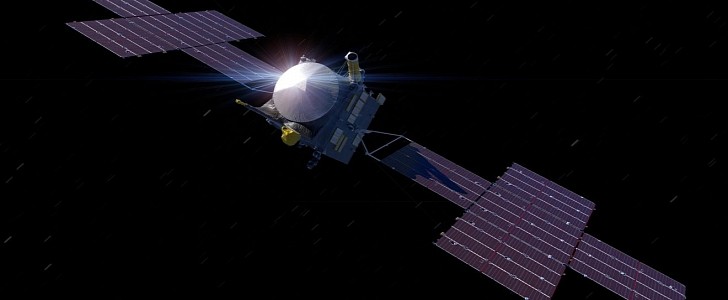NASA's Psyche spacecraft will launch in 2022 and travel about 1.5 billion miles (2.4 billion kilometers) to get to a rare metal-rich asteroid also called Psyche, which scientists believe may have once been a part of an early rocky planet. It will spend more than three years in space and will use solar electric propulsion to reach this unusual metallic asteroid.
The spacecraft will rely on the Falcon Heavy launch vehicle's huge rocket engines to blast off the launchpad and escape Earth's gravity. Once Psyche is separated from the launch vehicle, for the rest of the mission, Psyche will use solar electric propulsion. Large solar arrays will turn sunlight into electricity and provide the power source for the spacecraft's thrusters.
Psyche will use xenon as a propellant, the same neutral gas used in vehicle headlights and plasma TVs. The spacecraft's four thrusters will use electromagnetic fields to accelerate and expel xenon's charged atoms (ions). As the ions are ejected, thrust is created, slowly propelling Psyche through space and emitting blue ionized xenon beams.
NASA says that its thrust will be so subtle that it will feel as if you'd hold three quarters in your hand. However, it is enough to propel Psyche through deep space. With no atmospheric drag to slow it down, the spacecraft will eventually reach speeds of up to 200,000 mph (320,000 kph).
The spacecraft will launch from NASA's Kennedy Space Center. The Falcon Heavy will put the Psyche on a course to fly by Mars seven months later, in May 2023, for a gravity assist. The thrusters will do the delicate operation of putting the spaceship into orbit around the asteroid in early 2026.
Once in orbit, the mission crew will explore what this unusual metallic object may reveal about the formation of rocky planets like Earth. Over the course of the mission's 21-month science study, navigation engineers will use the spacecraft's electric propulsion thrusters to bring it closer and closer to the asteroid.
Psyche will use xenon as a propellant, the same neutral gas used in vehicle headlights and plasma TVs. The spacecraft's four thrusters will use electromagnetic fields to accelerate and expel xenon's charged atoms (ions). As the ions are ejected, thrust is created, slowly propelling Psyche through space and emitting blue ionized xenon beams.
NASA says that its thrust will be so subtle that it will feel as if you'd hold three quarters in your hand. However, it is enough to propel Psyche through deep space. With no atmospheric drag to slow it down, the spacecraft will eventually reach speeds of up to 200,000 mph (320,000 kph).
The spacecraft will launch from NASA's Kennedy Space Center. The Falcon Heavy will put the Psyche on a course to fly by Mars seven months later, in May 2023, for a gravity assist. The thrusters will do the delicate operation of putting the spaceship into orbit around the asteroid in early 2026.
Once in orbit, the mission crew will explore what this unusual metallic object may reveal about the formation of rocky planets like Earth. Over the course of the mission's 21-month science study, navigation engineers will use the spacecraft's electric propulsion thrusters to bring it closer and closer to the asteroid.






